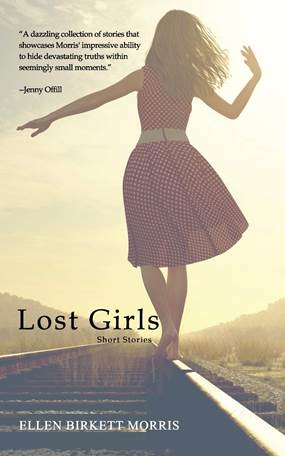Barefoot in a red polka dot dress, her back to onlookers, a wasp-waisted young woman teeters on the single rail of a train track. Arms akimbo, she tries to keep her balance. The image captures a single moment, leaving the viewer to wonder what’s next:
Does she tumble and fall; will she find sure footing and move on; is that a train in the distance, bearing down on her, or will she find a way to hop on board and take her one chance to get out of town?
The cover of “Lost Girls” by Ellen Birkett Morris is enough to lure anyone in search of a good summer read. In any season, those interested in work by an outstanding Kentucky writer will find this collection of short stories compelling. The interrelated characters comprise a unique sorority that includes kids who live in drab apartment complexes, motherless girls, chubby pre-teens, mourning mothers, friends reunited after many years’ absence, late bloomers, and a few who flowered too soon.
These are not nostalgic coming-of-age tales but clear-eyed enumerations of the negative space around being a woman. Morris, a Louisville native, intended for “Lost Girls” to “reflect the range of women’s experiences and get close to touching the truth about the challenges and joys of being a woman, chief among them being seen, acknowledged, remembered, and heard.”
The title story begins with an unemotional declaration: “When I was eighteen, thirteen-year-old Dana Lampton disappeared from the strip mall across from her family’s apartment.”
Instead of adopting the breathless tone of one of those Lifetime “ripped-from-the-headlines” dramas, the narrator candidly admits that she had grown up expecting, almost hoping, to be an abducted girl. “Not that anyone would notice if I was gone,” she declares.
She also remarks, “When I saw her parents on the television, arm in arm, united in their grief, I had a flash of envy.”
There is a reference to the abduction of Patty Hearst and the dreams of an Archie Bunker-type captor. Upon finally realizing she was too old to be kidnapped, she concludes that Dana Lampton took her place. The memory does not fade. Years later, she still contemplates the riddle of why it was Dana who was taken.

“I could only guess it was an accident of time,” the narrator says. “Who knows how often we cruise the aisles of the grocery store next to a sex offender or drive away from the convenience store as a robber pulls into the lot?”
The dangers and opportunities of random timing are the Tik-Tok soundtrack behind these stories. In “Kodachrome,” a young girl desperate to find her true colors in the drab landscape of adolescent life, risks exploitation by a photo-journalist who visits her school and community. Years later, on a high school field trip to a museum, she discovers a photo he took of her after she begged him to capture her image.
Timing is also a factor in “Neverland.” Two middle-aged women who were childhood friends are unexpectedly reunited in a grocery store. They are both buying cereal. Eileen picks a huge box of sugar-frosted flakes while Angie opts for oatmeal. Years before, they had lived with their families in Margate Apartments, the populace “a strange mix of the newly divorced, corporate transients, and young professionals.”
Angie recalls the “menacing impermanence” of the complex. “So much sadness lurked in those hallways,” she says. “Breakups, lost jobs, divorce, abuse.”
Another apartment complex, Westlake, is the setting of “Rumor of Fire.” Two bored girls become unofficial detectives regarding a mystery fire in the apartment laundry room. They make it a summer project to catch the culprit but end up witnessing another teen’s meltdown and making a devastating discovery about adulterous passion.
There are seventeen stories in “Lost Girls,” some just a few pages with others a bit longer. They all are page-turners to be read straight through or chosen at random. Whatever the sequence, they invite re-reading.
“Lost Girls” was published by TouchPoint Press. For more information about the author, one of Kentucky’s finest, visit ellenbirkettmorris.ink.

















